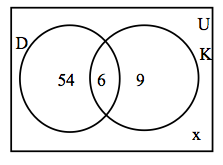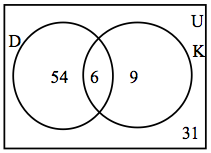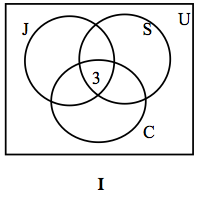Let
J represent the set of people who jog,
S the set of people who swim, and
C who cycle.
In using Venn diagrams, our ultimate aim is to assign a number to each region. We always begin by first assigning the number to the innermost region and then working our way out.
We place a 3 in the innermost region of Figure 11.0a because it represents the number of people who participate in all three activities. Next we compute x, y and z.
Since 14 people jog and swim, x+3=14, or x=11.
The fact that 9 people jog and cycle results in y+3=9, or y=6.
Since 7 people swim and cycle, z+3=7, or z=4.
This information is depicted in Figure 11.0b.
Now we proceed to find the unknowns m, n and p.
Since 50 people jog, m+11+6+3=50, or m=30.
Thirty people swim, therefore, n+11+4+3=30, or n=12.
Thirty five people cycle, therefore, p+6+4+3=35, or p=22.
By adding all the entries in all three sets, we get a sum of 88. Since 100 people were surveyed, the number inside the universal set but outside of all three sets is 100 – 88, or 12.
In Figure 11.0c, the information is sorted out, and the questions can readily be answered.
The number of people who jog but do not swim or cycle is 30.
The number who take part in only one of these activities is 30+12+22=64.
The number of people who do not take part in any of these activities is 12.
















